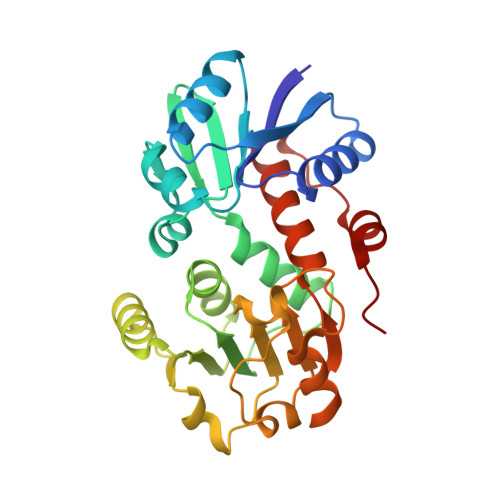Structural and mechanistic analysis of a novel class of shikimate dehydrogenases: evidence for a conserved catalytic mechanism in the shikimate dehydrogenase family.
Peek, J., Lee, J., Hu, S., Senisterra, G., Christendat, D.(2011) Biochemistry 50: 8616-8627
- PubMed: 21846128
- DOI: https://doi.org/10.1021/bi200586y
- Primary Citation of Related Structures:
3PWZ - PubMed Abstract:
Shikimate dehydrogenase (SDH) catalyzes the reversible NADPH-dependent reduction of 3-dehydroshikimate to shikimate. This reaction represents the fourth step of the shikimate pathway, the essential route for the biosynthesis of the aromatic amino acids in plants, fungi, bacteria, and apicomplexan parasites. The absence of this pathway in animals makes it an attractive target for herbicides and antimicrobials. At least four functionally distinct enzyme classes, AroE, YdiB, SDH-like (SdhL), and AroE-like1 (Ael1), utilize shikimate as a substrate in vitro and form the SDH family. Crystal structures have been determined for AroE, YdiB, and SdhL. In this study, we have determined the first representative crystal structure of an Ael1 enzyme. We demonstrate that Ael1 shares a similar overall structure with the other members of the SDH family. This high level of structural conservation extends to the active sites of the enzymes. In particular, an ionizable active site lysine and aspartate are present in all SDH homologues. Two distinct biochemical roles have been reported for this Lys-Asp pair: as binding residues in YdiB and as a catalytic dyad in AroE and SdhL. Here, we establish that the residues function as a catalytic dyad in Ael1 and, interestingly, in at least one YdiB homologue. The conservation of three-dimensional fold, active site architecture, and catalytic mechanism among members of the SDH family will facilitate the design of drugs targeting the shikimate pathway.
Organizational Affiliation:
Department of Cell and Systems Biology, University of Toronto, Toronto, Ontario, Canada M5S 3B2.














